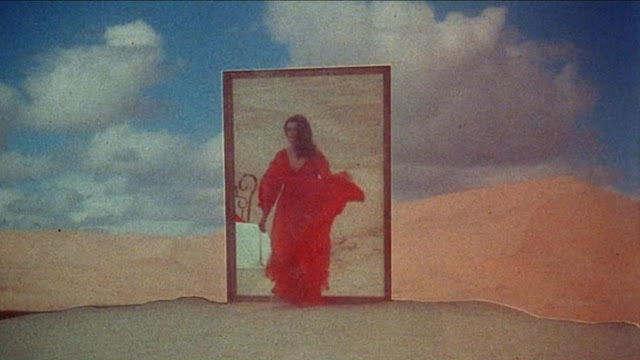“ever since that night at the gallery, ever since—I knew I wanted you. I was hungry for you as long as I could have you.”
Stephanie Rothman's 1971 film, The Velvet Vampire, isn't your average fang-tastic flick. Rothman co-wrote and directed a pioneering film that embodies the creativity and ingenuity of a female director in a largely male-dominated genre. With its unique take on the queer seductress vampire subgenre, Rothman shatters the conventional mold of passive female victims and instead elevates a strong and empowered female character to the forefront of the horror narrative. By standing out from the crowd and daring to tell a fresh and exciting story from a female perspective.
Diane LeFanu, portrayed by Celeste Yarnall, is a cultured and affluent individual with a profound appreciation for art and music. She takes a keen interest in the striking married duo, Lee (Michael Blodgett) and Susan (Sherry Miles) and cordially invite them to her desert retreat for an indulgent weekend. However, Diane hesitates to disclose her true identity as an age-old vampire who still mourns the loss of her husband, centuries past, and feeds on the unsuspecting intruders wandering on her property. As Lee and Susan become aware of their genial host's vampiric nature, they may become her next victims. The film pays homage to J. Sheridan Le Fanu's illustrious work, Carmilla (1872), by naming the vampire character Diane Le Fanu, who happens to be the first lesbian vampire protagonist and served as the inspiration for The Vampire Lovers.
While it did have a slow pace, it was totally worth it for its dreamy Technicolor eroticism and campy psychedelic trip. What I found particularly interesting was the setting of the film. Instead of your typical gothic castle or spooky woods, our vampire protagonist, Diane, resides in a modern mansion in the middle of the California desert.
I love Diane's fascinating wardrobe. She's always covered from head to toe to avoid the sun, so we get to see her in a variety of stylish sun hats and capes. And her clothing is just stunning - passionate reds when seducing men, and stiff yellows or whites when approaching women. It's an interesting choice that really adds to her character development. Now, I should mention that the script was written in just three months, but the director added some comedic elements to make it stand out from similar movies. The story may be simple, but the execution is imaginative and just plain beautiful.
Celeste Yarnall previously had substantial cameos in Live a Little Love a Little with Elvis Presley and Bob and Carol and Ted and Alice before being cast as the alluring, conflicted Diane.
Yarnall is simply delightful in this
movie- she exudes chill confidence and has an alluring gaze that just
draws you in! Watching her is a lot of fun. Unfortunately, Blodgett and
Miles, appear quite flat, passive, stilted, and dopey. We do get to see a
lot of him and the female leads get quite a bit of screen time in the
nude.
Michael Blodgett played a bevy of charming cads in Beyond the Valley of the Dolls, The Carey Treatment, then switched to screenwriting in the ‘80s, co-scripting Rent-A-Cop, Hero and the Terror, and Turner & Hooch. Sherry
Miles was a regular cast member in Hee Haw, known for her roles in Mod
Squad, The Beverly Hillbillies, Love, American Style, and The Partridge
Family. Sherry
Miles was a regular cast member in Hee Haw, known for her roles in Mod
Squad, The Beverly Hillbillies, Love, American Style, and The Partridge
Family.
Rothman was the first woman to receive a DGA fellowship during her studies at the University of Southern California and one of the first woman directors to work for a US studio. This led to a long working relationship with producer Roger Corman. She did everything learned in film school: write new scenes, scout locations, cast actors, direct new sequences and edit final cuts. Among the film were Beach Ball (1965), Voyage to the Prehistoric Planet (1965), and Queen of Blood (1966). She directed sections of Blood Bath (1966), followed by It’s a Bikini World (1970) and The Student Nurses (1970). The Velvet Vampire, also made under the aegis of Corman’s New World Pictures, was a modest hit for her. Rothman: "One of my greatest pleasures, determining how my style of shooting could enhance the content of a scene."
After teaming up with her husband Charles Swartz, Rothman helped establish Dimension Films in 1971. The company gained notoriety for producing a number of exploitation films. During her stint with Dimension, Rothman directed Group Marriage (1973), Terminal Island (1973), and The Working Girls (1974), in addition to writing Beyond Atlantis (1973). However, she and Swartz parted ways with the company in 1975. Rothman then attempted to venture into non-exploitation films, but unfortunately found it difficult.
The Velvet Vampire has become a cult classic over time, with some theaters even booking it as an art film. However, its distribution was never consistent, as people reacted differently to it and it was produced independently. It also had to compete with other vampire movies that starred big-name actors. Despite these challenges, it's still enjoyed a dedicated following and can often be found at various festivals and retrospectives.
The film was released during a time when there was a lot of feminist activism happening, especially around issues like work, sex, and family. Her unique approach to the subject matter is a testament to her talent and how much of a trailblazer she was. It's pretty cool that her work was celebrated with a retrospective at the Vienna International Film Festival in 2007.











